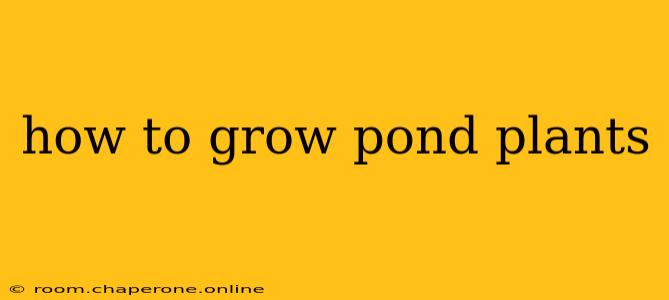Creating a thriving aquatic garden isn't just about aesthetics; it's about building a healthy pond ecosystem. Pond plants play a vital role in water quality, providing oxygen, filtering nutrients, and offering shelter for beneficial creatures. This comprehensive guide will walk you through everything you need to know about successfully growing pond plants, from choosing the right species to ongoing maintenance.
Choosing the Right Pond Plants
The key to success lies in selecting plants appropriate for your pond's size, depth, and sunlight exposure. Consider these factors:
1. Pond Size and Depth:
- Small Ponds: Opt for smaller, slower-growing varieties to avoid overcrowding. Consider marginal plants (those growing at the water's edge) and oxygenators that won't take over the space.
- Large Ponds: You have more flexibility with plant choices, including larger water lilies and bog plants. However, even in larger ponds, careful planning prevents unchecked growth.
2. Sunlight Exposure:
- Full Sun (6+ hours): Many water lilies, lotus flowers, and some marginal plants thrive in full sun.
- Partial Sun (3-6 hours): A wider range of plants will tolerate partial sun, offering more variety in your selection.
- Shade (Less than 3 hours): Choose shade-tolerant plants like certain ferns or aquatic grasses that can still flourish with limited sunlight.
3. Plant Types:
Understanding the different types of aquatic plants is crucial:
- Oxygenators: Submerged plants that release oxygen into the water, vital for fish and other aquatic life. Examples include Hornwort and Elodea.
- Marginal Plants: Plants that grow at the water's edge, in shallow water or wet soil. Examples include Irises, Cattails, and Pickerelweed.
- Floating Plants: Plants that float on the water's surface, providing shade and habitat. Examples include Water Hyacinth and Duckweed (use sparingly, as it can spread rapidly).
- Deep-Water Plants: These plants, like Water Lilies and Lotus, have roots anchored in the pond bottom and leaves floating on the surface.
Planting Your Pond Plants
The planting method depends on the plant type:
1. Planting Oxygenators:
Simply place the plants directly into the pond water. They will root themselves naturally.
2. Planting Marginal Plants:
Plant these in pots or baskets filled with aquatic soil and placed in shallow water along the pond's edge. This allows for easy removal and control of their growth.
3. Planting Floating Plants:
Gently place these plants on the water's surface. They will naturally float and spread.
4. Planting Deep-Water Plants:
These require specialized containers with aquatic soil, weighted down to keep them submerged. Place the containers in deeper parts of the pond.
Ongoing Care and Maintenance
Maintaining your pond plants requires regular attention:
1. Regular Weeding:
Remove unwanted algae and invasive weeds promptly to prevent them from choking out your desirable plants.
2. Fertilizing:
Some plants may benefit from slow-release aquatic fertilizers, but avoid over-fertilizing, which can lead to algae blooms.
3. Pruning:
Prune back overgrown plants regularly to prevent overcrowding and maintain a balanced ecosystem.
4. Winter Protection:
Some plants require winter protection, particularly in colder climates. This may involve moving potted plants indoors or covering them with mulch.
Troubleshooting Common Problems
- Algae Blooms: Excessive nutrients in the water cause algae blooms. Address this by removing excess nutrients, improving water circulation, and introducing more oxygenating plants.
- Plant Decline: Yellowing leaves or stunted growth can indicate nutrient deficiencies or disease. Adjust your fertilization strategy or consult a pond specialist if problems persist.
- Overgrowth: Regular pruning and thinning are crucial to prevent overcrowding and maintain a healthy balance.
By following this guide, you can create a vibrant and healthy pond ecosystem bursting with beautiful aquatic plants. Remember that patience and observation are key to successful pond planting. Happy gardening!

